26 May 2023
Global Market Outlook
Global Market Outlook
Beyond the peak
A potential Fed pause and ‘less bad’ US macroeconomic data are likely to collide with still-poor long-term fundamentals. We would use any near-term rallies in risk assets to reduce risk.
In our foundation allocation, within equities, we upgrade Japan to Overweight, retain our Asia ex-Japan Overweight and trim the US to a modest Underweight. Within Asia ex-Japan, we trim China to Neutral. Our sector picks remain largely defensive in the US and Europe and cyclical in China.
In fixed income, we retain our Overweight on Developed Market Investment Grade government bonds and Asia USD bonds. We see multi-asset income strategies as still offering an attractive yield.
Are high quality bonds the only recession-proof assets?
What are the pros and cons of an income allocation?
What are the key macro factors to watch in the coming weeks?
Strategy
Investment strategy and key themes
|
|
||||
|

Our top preferences
(12-month outlook)
Foundation Overweights
- Government bonds, gold
- In equities: Japan, Asia ex-Japan
- In bonds: Developed Market Investment Grade government bonds, Asia USD bonds
Sector Overweights
- US: Healthcare, Staples, Communication Services
- Europe: Healthcare
- China: Comm. Services, Consumer Discretionary
FX views
- Modestly weaker USD
Structural macro trends*
- A digital tomorrow
- Preparing for an ageing world
- From unipolarity to multipolarity
- Investing in a climate-constrained world
*Individual reports available
Beyond the peak
- A potential Fed pause and ‘less bad’ US macroeconomic data are likely to collide with still-poor long-term fundamentals. We would use any near-term rallies in risk assets to reduce risk.
- In our foundation allocation, within equities, we upgrade Japan to Overweight, retain our Asia ex-Japan Overweight and trim the US to a modest Underweight. Within Asia ex-Japan, we trim China to Neutral. Our sector picks remain largely defensive in the US and Europe and cyclical in China.
- Within bonds, we retain our Overweight on Developed Market Investment Grade (IG) government bonds and Asia USD bonds. For income investors, we continue to see a greater reliance on bonds as attractive for multi-asset income strategies.
Life after the pause
The Fed appears set to pause rate hikes, but the US macro backdrop remains a difficult one. On the positive side, headline measures of inflation continue to soften in the US, the pace of deterioration in some growth indicators has started to slow and corporate earnings surprised to the upside in Q1. However, inflation remains far above the 2% level. Most forward-looking growth indicators remain weak, with the tightening of bank lending conditions being the latest data point to signal weaker growth ahead. Therefore, we continue to believe an economic recession is likely, accompanied by declines in corporate earnings, equity markets and bond yields.
There is a case for equities remaining supported over the next few weeks. History shows that equity markets have indeed risen in many (albeit not all) cases in the six months after the Fed paused rate hikes. Some measures of investor positioning also remain excessively bearish, which as a contrarian indicator, often points to a rebound or at least sideways support in the following months.
Fed pause amid weak fundamentals not so bullish. As Fig 2 illustrates, pauses in Fed rate hiking cycles when the US bond yield curve is inverted (ie, the yield on longer maturity bonds are lower than those on shorter maturity bonds) have not really been supportive for equity markets. This is probably because an inverted yield curve has been a reasonably reliable predictor of an economic recession.
Fig.1 Fed pause not necessarily positive for equities if yield curve is inverted, as is the case today
S&P500 performance after a Fed pause
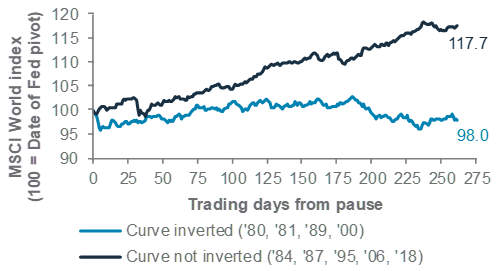
This learning from history argues that while global equities could very well rise in the short term, such rallies are likely to provide opportunities to reduce exposure in favour of high-quality bonds, and not seen as bull runs to be chased.
Shifting our regional preferences
Within our equities Underweight, we continue to believe a selective regional and sectoral approach is key to improve investment returns (see page 5 for suggested allocations).
We raise Japanese equities to Overweight. It is tempting to conclude that our view of a stronger JPY over the next 12 months should lead to Japanese equity underperformance vs global equities. However, today we believe three positives outweigh the negatives. First, relatively higher inflation, if even partly sustained, raises the chances of higher nominal economic growth. This should translate to higher corporate earnings growth. Second, a surge in share repurchases should offer a key source of support. Third, these changes come against a backdrop of improving corporate governance and still inexpensive valuations.
Fig. 3 China bond yields, currency turned lower following recent data disappointments
China 10y bond yield, USD/CNY
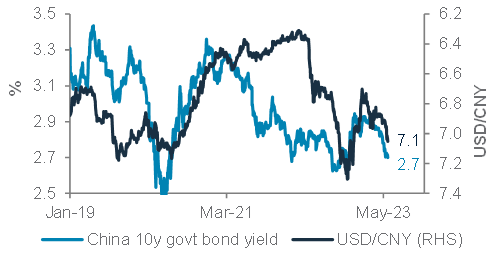
We retain our Overweight on Asia ex-Japan equities but close our preference for China within this region. It is likely that China’s economy is moving past its ‘sweet spot’ in terms of peak positive economic and earnings surprise. This suggests further growth from here is likely to be increasingly
Fig.2 Tightening US loan standards usually signal a jump in yields on HY bonds
Fed senior loan officer survey % tightening standards

dependent on policy actions to sustain growth. This is why we would retain our Overweight on Asia ex-Japan equities – of which Chinese equities hold about a 35% weight – but trim our risk by moving Chinese equities within Asia ex-Japan to Neutral.
We reduce US equities to a marginal Underweight. Our downgrade still leaves US equities as a sizeable proportion of diversified portfolios (see page 5). However, our view of continued USD weakness on a 6-12-month horizon means it becomes increasingly likely that non-US equities outperform US equities in the long term. In terms of US equity market sectors, we retain an Overweight on healthcare and staples, which offer a defensive tilt, but upgrade communication services to Overweight given its strong earnings momentum.
Staying sensitive to bond yields
Within bonds, we continue to prefer high-quality bonds that benefit from a fall in government bond yields, although that conviction has moderated slightly, marginally lowering our overall bonds view to neutral. We remain Overweight on Developed Market (DM) IG government bonds given we expect the US 10-year yield to fall below 3% in 12 months. Moreover, the bonds are also not directly exposed to the risk of rising corporate bankruptcy risk during recessions. We also retain our Overweight on Asia USD bonds, while emphasising our relative preference for Asia IG bonds. Asia High Yield (HY) bonds remain at risk from credit quality deterioration, particularly given the China real estate sector’s weight within this sub asset class.
Extending bond maturity, technology sector equities and gold are other ways to benefit from falling bond yields. As we discuss in more detail in Perspectives, several non-bond asset classes, such as US technology sector equities (we are Neutral) and gold (we are Overweight) can also offer interesting exposure around recessionary periods, especially when considering the difficulties in timing the precise start and end of recessionary periods.
For income investors, we continue to Overweight bonds over equities. Within multi-asset income strategies, we now prefer DM HY bonds over leveraged loans, while remaining neutral between DM HY and subordinated financials.
Foundation: Our tactical asset allocation
Global* allocation for a moderate risk profile

Multi-asset income allocation for a moderate risk profile


Foundation: Multi-asset income strategies
|
|
||||
Key themes
Our multi-asset income (MAI) allocation has delivered positive returns outlook to date, eking out a 0.5% return. The banking crisis in April has negatively impacted subordinated financials and the financial equity sector, which are core components within hybrid income and global dividend equities.
We still find the income allocation attractive. The c.6% yield on offer on our income allocation remains attractive, in light of a likely pause in Fed rate hikes. There is a risk though that a greater allocation towards Value style equities, particularly in the financial and energy sectors, could weigh on total returns if the US and Europe enter a recession over the next 12 months.
We continue to favour a heavy tilt towards fixed income at the expense of equity. The high absolute yields derived from fixed income assets continue to look attractive vs yield from high dividend equities. Downside risk to corporate earnings remain a risk, as credit is further tightened. Our investment committee ascribes over 70% probability of a US recession over the next 6-12 months. Slower economic growth or a recession typically benefits bond assets relative to equities. Within bonds, we now prefer DM HY bonds over leveraged loans, while continuing to be neutral between DM HY bonds and subordinated financials.
Key chart
While fixed income assets form the bulk of our allocation, a diversified allocation is always key
Fig. 4 Yields on the MAI portfolio still largely supported by fixed income assets
Yields, duration and allocations of bonds, equity and hybrid assets within our multi-asset portfolio

Fig. 5 Yields on income assets remain near multi-year highs, although some have fallen to the lower end of range
Yield to worst/dividend yield (%), yield range of various income assets since 2014

Contingent Convertibles are complex financial instruments. (Refer to Important Information on page 21 for further details)
Income allocation remains attractive
Our Income allocation has delivered positive returns of 1.3% outlook to date. Our heavy tilt to fixed income assets account for the bulk of the YTD returns. This was, however, offset by the drags from non-core income as well as global dividend-paying equities, which were negatively impacted by a string of regional bank failures, hurting the performance of financial sector equities and subordinated financial sector bonds.
We still believe there is value in income allocation. The c.6% yield on offer on our income allocation continues to look attractive, considering a likely pause in Fed rate hikes. This benefit is, however, partly offset by a greater allocation towards Value style equities, particularly in financial and energy sector equities, which tend to underperform going into a recession. Also, diversified income strategies generally have a larger exposure to corporate bonds than DM government bonds. Thus, this part of the allocation weighs on total returns for such strategies during periods of recession.
Fig. 6 Our MAI Strategic Asset Allocation has generally delivered positive returns while attaining attractive yields
Yearly performance of MAI SAA and yield
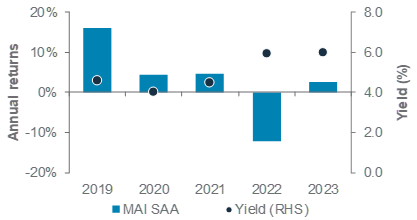
Quality coupon and increasing protection
Macroeconomic data continues to confirm our view of an economic slowdown and heightened recession risk in the US. The global leading indicators we track in our recession dashboard have declined for 13 consecutive months. The latest Fed Loan Officers’ survey also points to tightening lending standards and potential downside risks to growth and earnings in H2. If our view of a US recession proves to be correct, this would imply wider credit spreads and potentially lower bond yields as markets increasingly price in rate cuts as growth outlook deteriorates.
Therefore, we have continued to add to our allocation in quality bonds, particularly in Developed Market (DM) government and Investment Grade (IG) corporate bonds, at the expense of High Yield (HY) and leveraged loans over the previous month. Credit spreads are likely to widen, more so for HY than for IG bonds. Any Fed policy easing in the event of a recession would put further downward pressure on bond yields. This would favour DM government and IG bonds over HY bonds and leveraged loans, in our view.
We have also added to Asia USD bonds to boost our overall IG exposure. We believe this asset class will continue to benefit from China’s economic recovery and pro-growth policies. While the recovery has been slower than expected, the yield on offer is attractive at c.6.9%, with more than 80% of Asia USD bonds index composed of IG bonds. China’s authorities are also likely to maintain accommodative policies, compared with tighter policies seen in Developed Markets.
Within DM bonds, we have a greater allocation to DM HY bonds relative to leveraged loans. Historically, bond yields have peaked around the last Fed rate hike. We expect DM HY bonds to outperform leveraged loans as the Fed shifts to an easing cycle, as we expect during a recession. With Fed rates at or close to a peak, the case for floating loans is greatly reduced. Credit quality of DM HY bonds is better than those of leveraged loans in this credit cycle, in our view, enabling the former to hold up better during a recession.
Dividend equities and hybrid income taking a backseat
We continue to be comfortable underweighting dividend equities. Yields on global dividend equities are a tad lower than DM IG corporate bonds. The recent performance in global dividend equities has also been negatively impacted by the performance in the energy and financial sectors.
We have increased our allocation to covered calls at the expense of high dividend equities. Covered calls have been resilient, given their exposure to global equities, with a greater sectoral exposure to technology, which has risen c.27% YTD. Higher volatility in the near term is also likely to help boost covered call performance, given the increase in premiums received to compensate for market instability.
Fig. 7 Finding income while managing downside risk is becoming more challenging
Average annual drawdowns since 2014
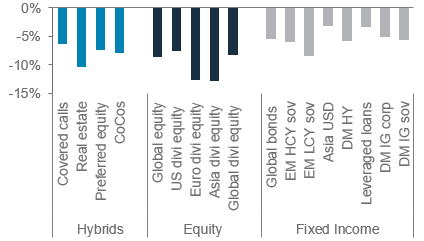
We retain a neutral stance between subordinated financial relative to DM HY bonds. While assets such as Contingent Convertible bonds and preferred equity are largely backed by financial institutions with high interest coverage ratios and yields are at the higher end of the range, investors are likely to reassess their exposure to these financial hybrids. We will wait for better opportunities to add.
Perspectives on key client questions
|
|
||||
Are high-quality bonds the only recession-proof assets?
According to Bloomberg, c.26% of Investment Grade corporate bond sales this year have been in securities maturing in 30 years or longer. The surge in sales of long-term bonds has occurred alongside robust performance in global technology and Growth stocks, despite mounting expectations of a recession. Additionally, flows into gold by institutional investors have also increased sharply, as investors hedge against lower yields and downside risks in equity markets.
The strong flows into these assets share a common driver. They reflect an emerging interest in ‘duration’, or assets with a relatively high sensitivity to changes in interest rates. Markets are expecting Fed rate cuts later this year and bonds are expected to be a winner from a slowing economy and any potential Fed easing.
Why is sensitivity to interest rates attractive today?
Bonds are an attractive way of gaining exposure to interest rate moves, especially if the main concern is about a severe recession. The risk of any upside in bond yields (ie, downside in prices) is likely to be capped, while the extent of the fall in yields (rise in prices) is usually linked to the severity of a recession. This, in our view, offers an attractive asymmetrical return profile at this point in the cycle. Given our view a recession is likely in the next 12 months, we are Overweight DM government bonds and prefer a long maturity profile (ie, long duration).
Timing a recession remains difficult, though. This is where considering a broader basket of assets, which balances sensitivity to interest rates, with longer-period of returns can help. Hence, other than having a long-duration bias, we believe it is important for investors to also consider assets that can benefit ‘through the cycle’, ie, delivering positive performance cumulatively during periods when recession probability is rising, during a recession and after a recession.
In this analysis, we compare the performance of various assets leading into, during and after a recession to identify those that can yield the best returns cumulatively from lower interest rates, despite recession headwinds. We find that while some rate-sensitive assets can lose value during a recession, their performance before and after the recession can more than make up for those losses, making them potential candidates to consider, in addition to a more traditional approach to rate sensitivity via high-quality bonds ahead of recessions.

Fig. 8 The probability of a US recession in the next twelve months is at its highest since the late 1970s
Probability of a US recession in the next 12 months

Source: Federal Reserve Bank of New York, Standard Chartered
Government bonds an attractive hedge
A typical way to gain rate sensitivity is through long-maturity government bonds. Long-term US government bonds outperform other asset classes during recessions, but offer modest returns before and after recessions. This makes them attractive assets to own, particularly if one expects a recession is near.
Investment Grade corporate bonds, another option. MajorIG corporate bonds have maturity profiles approximately twice those of HY corporate bonds. While IG corporate bond returns underperform those of government bonds during recessions, this is historically more than compensated by its outperformance three months after the end of a recession.
The higher yields on short-maturity government bonds appear tempting today, but they usually come with a high opportunity cost in terms of missed returns during recessions as yields decline. Meanwhile, HY bonds can offer potentially outsized gains during the recovery, but often face significant volatility during recessions. This is partly why we currently hold an Underweight view on DM HY bonds.
Fig. 9 IG corporate bonds offer better ‘through cycle’ cumulative returns
Cumulative returns of US fixed income assets before, during and following a recession*
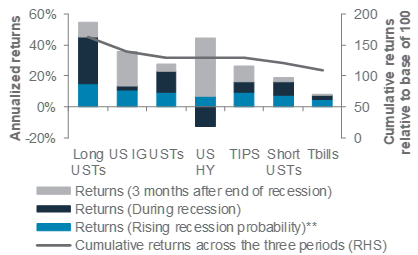
**Period of rising recession probability is defined as the period between the rise in recession probability above its historical average of 15% and the start of a recession
Source: Bloomberg, Standard Chartered
Tech equities attractive ‘through cycle’
Other than bonds, investors can also gain recession-relevant exposure through other assets. For example, changes in interest rates can impact equity valuations. The finance textbooks tell us that companies are valued based on their future earnings, discounted by the level of interest rates. When interest rates rise (or fall), this ‘discount rate’ used to value the earnings stream increases (or decreases). This, in turn, leads to a decline (or rise) in the present value of these earnings and hence the value of equities.
Technology sector equities can offer an interesting return profile when returns before and after a recession are considered. While the sector unsurprisingly has faced drawdowns during recessions, history shows us that the
cumulative returns before and after recessions can more than make up for these declines (Fig. 10). This suggests technology sector equities can be an interesting addition given the uncertainty surrounding the start and end of a recession. Our investment committee holds a Neutral view on the sector, given the trade-off between more attractive longer-term returns and the drawdown during recessions.
Fig. 10 US technology sector stocks yield the highest cumulative returns, despite losses, during recession
Cumulative returns of US equity sectors before, during and following a recession*

Gold, an all-round performer
Gold benefits from lower real interest rates and has low correlation to other asset classes, making it an attractive portfolio diversifier. The cumulative returns for gold before, during and following a recession over the past recessionary episodes are higher than other major asset classes. As an interest rate sensitivity trade, however, it is more influenced by real yields rather than nominal yields. This means that if inflation expectations decline faster than nominal yields, real yields would rise, and gold prices could instead fall. Investors looking to express interest rate sensitivity trades via gold thus need to be mindful of the other factors driving gold prices.
Fig. 11 Gold is a good hedge against a recession but not the perfect asset to benefit from interest rate moves
Cumulative returns of major global assets before, during and following a recession
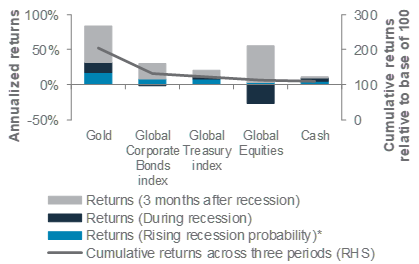
Macro overview at a glance
Summary
|
Key themes
Asia to support global growth on the back of consumption: We expect China, and Asia ex-Japan more broadly, to drive global growth this year as the US likely enters a mild recession by Q4 and Europe slows sharply due to tighter monetary policies. However, China’s recovery from the pandemic appears to be faltering, with industry and exports hurt by slowing global demand for goods. We expect China’s policymakers to provide targeted stimulus to sustain the domestic consumption recovery and revive private investment, job creation and the housing market for first-time buyers.
Inflation to stay above target in the US, Europe; disinflation in China: We expect inflation to soften further globally as supply bottlenecks ease. However, inflation in the US and Europe are likely to end the year well above the central banks’ 2% target as strong job markets sustain service sector inflation. China’s inflation is likely to stay subdued.
Fed, ECB, PBoC to diverge: We now expect the Fed to hold rates at a cycle high of 5.25% until Q3 23 due to elevated inflation, before cutting 100bps by Q2 24 as a mild recession sets in. Meanwhile, the ECB is likely to hike by 50bps to 3.75% by Q3 23 and hold it there until Q1 24. The PBoC is likely to ease policy further in H2 23 to support the recovery.
Key chart
China’s economic data have underwhelmed lately after a period of significantly positive surprises. However, China’s consumption continues to recover strongly and there are nascent signs of a revival in the housing market
Fig. 12 China’s data surprises have rolled over, but consumption is rebounding
Citi economic surprise indices; China’s retail sales and new homes prices

Macro factors to watch
- US debt ceiling risk: The US government running out of cash by June/July is the most immediate macroeconomic risk. We still see a last-minute deal between the Democrats and Republicans to raise the debt ceiling as the base scenario, given that neither party wants to be seen as the cause for a maiden US debt default. We expect ongoing talks between President Biden and House Speaker McCarthy to lead to a higher debt ceiling, just enough for the government to meet its expenses until the end of the year. The harder task would be to agree on the Republican demand for significant spending cuts when budgeting for the new fiscal year starting in October. Meanwhile, any near-term raising of the debt ceiling could lead to a spurt in government borrowing, as the Treasury replenishes its reserves. The Fed may need to end quantitative tightening to offset the liquidity crunch.
- US, Europe recession risk: We see more than 70% probability of a US recession, most likely around the end of the year. All leading indicators, except for the job market and consumption, are pointing to a recession over the next 12 months. We expect the 500bps of Fed policy tightening over the past year to impact growth with a lag by the end of the year, leading to a softening of the job market. The Fed is likely to start cutting rates in Q4 once the unemployment rate likely rises past 4%, but any rate cut is likely to be modest, given the still above-target inflation. The ECB, meanwhile, is likely to be constrained by still-elevated inflation and resilient growth, forcing it to hold the deposit rate at a cycle high of 3.75% until Q1 24.
- More China stimulus: External headwinds restraining China’s manufacturing and exports mean more support from Beijing to sustain domestic consumption. The May Golden Week holidays showed leisure travel and spending surpassed pre-pandemic levels, although per capita spending was relatively muted. We expect the authorities to provide targeted incentives to lift consumer demand, entice first-time home buyers, revive private investment in strategic industries and boost job creation. The PBoC is also likely to ease credit to support growth.
Asset Classes
Bonds – at a glance
|
|
||||
Key themes
We remain Overweight government bonds given our expectation of slower US growth in the next 12 months. In addition to weak US economic activity data, regional banking crisis and tighter financial conditions, the protracted US debt ceiling talks are likely to bolster risk-averse positioning towards risk-free government bonds. Even if a resolution is reached, it could involve budget spending cuts just as the economy is slowing. This raises the prospect of further decline in government bond yields.
Our Overweight on DM IG government bonds remains in place. Our expected range for the 10-year US government bond yield by end-March 2024 is 2.75-3.00%. Concern over (i) the US debt ceiling and (ii) the impact on liquidity following the US banking turmoil could keep bond market volatility elevated, but we would use any rebound in yield to add exposure.
We remain Overweight on Asia USD bonds, with a relative preference for IG bonds. While Asia’s regional growth should remain supported by China’s pro-growth policies, softer economic growth data of late and concerns about slower global growth reinforce our preference for high quality bonds. The outlook for the Chinese HY bond sector remains mixed; Chinese property bonds, which contribute one-third of the segment, remains under pressure from sluggish industry recovery and idiosyncratic risk.
We are Neutral on DM IG corporate bonds and Underweight DM HY bonds. We believe current yield premiums over Treasuries, particularly for HY bonds, are still insufficient to compensate for a likely US recession. We areNeutral EM local currency (LCY) and EM USD government bonds. Although EM USD bonds have benefited from falling US bond yields, elevated external debt levels and potential negative impact from a US recession could lead to further decline in credit quality.
Key chart
We expect the US 10-year government bond yield to fall once the debt ceiling is lifted, as a likely tightening of fiscal policy weighs on growth; Asia IG bonds remain preferred to Asia HY bonds
Fig. 13 If history repeats itself, the US 10-year government bond yield is likely to fall after the debt ceiling issue is resolved; Asia HY credit fundamentals remain weak
US 10-year government bond yield changes +/- 90 days around debt ceiling resolution; net upgrades/downgrades of Asia IG and HY bond issuers

What is your view on the US bond yield curve and its sensitivity to interest rate changes?
The US government bond yield curve remains inverted, with the 6-12-month yields lower than the 10-year yield. The shorter maturity bond yields have broken above 5% on the back of more hawkish Fed guidance and concerns about a possible temporary US debt default.
Although longer maturity bond yields (10-year yield at c.3.7% and 30-year yield at c.3.9%) are lower than the yields offered by shorter maturity bonds, we still find the longer maturity bonds as more attractive due to their potential for greater price gains if the US enters a recession. The higher interest rate sensitivity of long-dated bonds means their price changes by a larger extent than shorter-maturity bonds for the same
movement in bond yields. Hence, we see value in being Overweight on longer maturity bonds (7 years or longer).
Nevertheless, we expect the short-term yield to drop by a larger magnitude (in terms of bps) than the longer-term yield once the US debt ceiling issue is resolved. On a 3-12-month horizon, market expectation of Fed rate cuts is likely to put further downward pressure on short-term yields, leading to a steeper yield curve (short-term yields likely to fall more than long-term yields). However, there is a risk of a sharp increase in US Treasury bill issuance once the US debt ceiling is lifted after a deal. We will continue to track the discussion between the two US parties and evaluate the longer-term impact, based on the nature of any debt ceiling agreement.
Equity – at a glance
|
|
||||
|
Key themes
We remain Underweight global equities on a 12-month horizon, as we expect a recession in the US and growth slowdown in Europe to weigh on corporate earnings and equity market returns.
We are upgrading Japan to Overweight. Besides cheap valuation, Japan’s economic data, such as GDP growth and private consumption, have been beating expectations. Corporate governance has been improving – companies have been increasing their dialogue with investors, while share buyback reached a record high of USD 71bn for the financial year ending Mar-23.
We remain Overweight Asia ex-Japan where we believe the Chinese government is likely to deliver targeted stimulus to support growth. Chinese companies are expected to deliver stronger earnings compared to other regions. However, China economic surprises are off their peak after the pandemic reopening so we downgrade China to Neutral within Asia ex-Japan. We are Neutral India within Asia ex-Japan, where relative valuation continues to adjust down closer to the long-term average.
We are Neutral Euro area equities where the significant valuation discount is rightly, in our view, pricing in vulnerabilities to growth. We are Underweight UK equities where we see the weakest earnings growth this year offsetting its low valuation. Finally, we have downgraded US to Underweight on the margin. Valuation remains elevated and we believe earnings are likely to suffer once the US enters a recession. Risks to our view: (1) stronger-than-expected US economy; (2) stronger-than-expected earnings growth in the US and globally; (3) weaker-than-expected growth and earnings in China and Japan.
Key chart
China’s earnings growth has been upgraded, while the US’ has been downgraded since the start of the year; Japan’s equity markets have seen consistent fund inflows, boosting investors sentiment
Fig. 14 China’s EPS growth will likely stay elevated, supported by post-pandemic recovery. Japan’s market has recorded 6 consecutive weeks of foreign net inflows
Consensus EPS growth among major MSCI indices. Foreign investor inflows into Japan’s equity market YTD.

Recession fears shift focus to Asia market
Rising recession fears in both the US and Europe have weighed on earnings growth expectations. We believe that risky assets are likely to face downside and thus we are Underweight global equities over the next 12 months. We downgrade US equities to a marginal Underweight as an expected weakening of USD benefits non-US equities.
In contrast, we suggest switching into Asia markets amid a relatively more appealing outlook. We upgrade Japan equities to Overweight, supported by attractive valuations (the MSCI Japan index is trading at a 9.2% discount to MSCI All-Country World index), returning foreign inflows and improving corporate governance, which have boosted investor sentiment. Japan’s lower exposure to geopolitical risks vs with Asian peers should also help the market outperform global equities over the next 12 months.
We remain Overweight on Asia ex-Japan, as ongoing recovery from China’s reopening has resulted in better-than-expected Q1 23 earnings. Valuations remained attractive, with light investor positioning. Recession fears in the US should also drive fund inflows into Emerging Markets, in our view. That said, we have turned Neutral on China relative to Asia ex-Japan, and remain Neutral on China offshore vs onshore equities, as geopolitical risks offset rising earnings growth expectations. We are Neutral on India equities as valuations remain stretched.
We are Underweight UK equities as domestic fund inflows are lagging even with a stronger GBP. We remain Neutral Euro area equities – falling equity risk premium could reverse with monetary tightening, offsetting potential opportunities from a weak long-term investor positioning.
Equity sector views
|
Staying defensive in DM
Buy consumption recovery in China
- We stay defensively positioned in the US and Europe sectors, in line with our cautious view on global equities.
- Meanwhile, we would continue to buy the consumption recovery in China through the communication services and consumer discretionary sectors.
US
We see three sectors that are likely to outperform the broader US market. Healthcare provides defensive exposure with reasonable valuation. New oncology and obesity products are expected to support growth, while AI could accelerate drug development and reduce costs. Consumer staples has historically delivered positive EPS growth even in a recession and is seen as a reliable outperformer in a downturn, with strong pricing power. Communication servicesis upgraded to Overweight given its strong earnings momentum. Communication is the only sector to enjoy 2023 earnings upgrades since the start of the year and valuation remains at an attractive discount to its historical average.
Other views: We are Underweight materials as it is vulnerable in a cyclical slowdown. We downgrade real estate to Underweight as higher interest rates continue to weigh on property prices. We upgrade financials to Neutral as the US banks’ drawdown of over 40% from its peak reflects the current risks, in our view. The sector also historically does well after the last rate hike.
Europe
We upgrade healthcare to Overweight, replacing utilities as our defensive pick. Healthcare offers attractive growth for its valuation, with an earnings profile currently above the market.
Fig. 15 We expect China’s consumption rebound to benefit communication and discretionary sectors
Consensus 12m forward EPS growth by sectors in China

Other views: We are Underweight real estate as price momentum remains poor. Rising rates are an ongoing headwind with credit defaults seen in the sector. We downgrade materials to Underweight as the sector is cyclical, with the risk of further earnings weakness in a slowdown.
China
We see value in the two China sectors we consider a Buy. Communication services is dominated by media and entertainment companies that we believe will benefit from greater consumer spending, a recovery in advertising and policy support for internet platforms’ development. Earnings revision in the sector has rebounded strongly. We also see consumer discretionary as a beneficiary of the ongoing reopening and policymakers’ priority in boosting domestic consumption. Consumer activities should recover through the year as household incomes rise further and excess savings are released gradually amid a recovering economy.
Other views: We are Underweight real estate as we expect it to lag a rebound in China equities. Residential properties appear overpriced in tier 1-2 cities and overbuilt in lower tier cities. We downgrade technology to Neutral as investors fear the negative impact of US export controls on the sector. Industrials is also downgraded to Neutral as it could also be impacted by advanced technology restrictions from the US.
Fig. 16 Our sector views by region

FX – at a glance
|
Key themes
Our bearish USD view remains in place over the next 3-month and 12-month horizons, especially after the recent rebound. The most recent rebound in the USD Index (DXY) correlates closely with the rebound in US government bond yields. The rise in select measures of US inflation expectations and some Fed policymaker comments that they would not rule out 1-2 more rate hikes likely contributed to the yield, and the USD move higher. It is also possible a protracted debt ceiling negotiation leads to temporary safe haven demand for the USD as well.
However, we continue to view this rebound as an opportunity to sell the USD on both 3- and 12-month horizons. On a 3-month horizon, we believe the Fed policy rate cycle has peaked and the rise in bond yields is unsustainable. On a 12-month horizon, we believe relative yields are likely to continue moving against the USD, especially if the US economy underperforms other major economies in relative terms.
EUR/USD to rise towards 1.09-1.10, USD/JPY to fall towards 133-134 over the next three months. Unlike the Fed, we do not see the ECB altering its tightening bias for now, given the relatively stronger growth and greater inflation pressure. USD/JPY also has room to reverse its initial disappointment from the BoJ ruling out any immediate change to its Yield Curve Control (YCC) policy. We believe that the pressure on the BoJ to scrap the policy is unlikely to go away amid rising inflation in Japan.
We expect GBP/USD rising toward 1.25 over the next three months. This view continues to be based on our view that strong jobs and wage growth and inflation data continue to make more BoE rate hikes likely. We still expect USD/CHF to remain relatively well-supported, with a three-month USD/CHF forecast at 0.91. However, risks are clearly skewed towards the downside, especially if safe haven for CHF demand jumps during the ongoing fractious US debt ceiling negotiations.
Commodity currencies (AUD, NZD and CAD) are likely to remain better supported than the CNY as we pass the peak in positive Chinese economic surprises. Our three-month expectations for AUD/USD remain unchanged at 0.68, with support likely to return if more Chinese policy support to boost growth is forthcoming. USD/CNY is likely more sensitive to US-China government bond yield differentials. We see a move back below 7.00 more likely over a 12-month rather than a 3-month horizon.
Key chart
The EUR and JPY should rise near term if the USD gains reverse. The CHF is most likely to see a temporary spike if safe haven demand jumps.
Fig. 17 Rise in US bond yields likely behind recent USD gains; we do not expect this to last
US 2y bond yield vs USD Index; table of forecasts

What is your view on major Asian currencies, including the SGD?
The Singapore monetary authority’s shift to a neutral stance at its last policy meeting likely means the global backdrop is likely to become an increasingly important driver of the SGD. Given the likely mix of the policy basket, the SGD should benefit from a weaker USD and CNY. We expect a modest fall in USD/SGD to 1.32 in 12-months.
USD/INR is likely to continue oscillating between 81 and 83 as policymakers lean against INR gains caused by a broadly weaker USD. However, we expect modest INR gains to ultimately dominate and expect USD/INR to move lower to 81 in 12 months.
USD/KRW is likely to fall to 1,250 in 12 months on broad USD weakness. USD/MYR’s fall, however, could be delayed as CNY weakness dominates in the short term.
Gold, crude oil – at a glance
|
Key themes
We stay Overweight gold vs other major asset classes, with a 12-month forecast of USD 2,120/oz.Gold started May strongly due to the US debt ceiling impasse, before retracing below 2,000 on higher real (net of inflation) yields and stronger USD. However, we do not expect these headwinds to persist. A likely end to the Fed rate-hiking cycle in H1, followed by rate cuts in Q4, mean that real yields and the USD would likely moderate. Furthermore, net positive flows into gold ETFs are likely to continue as investors seek a hedge against macro and geopolitical uncertainties, especially given a structural under-allocation. Continued central bank and physical demand are the other key drivers behind our constructive view.
We continue to see limited near-term upside for oil and have a 12-month WTI oil forecast of USD 65/bbl. The oil markets have given back most of its post-OPEC-cut gains in May, as investors stayed cautious due to macroeconomic gloom and the US bought only 3m barrels (approx. 1% of SPR) to refill its depleted Strategic Petroleum Reserve (SPR). Investor positioning is now as bearish as in March, before the OPEC+ cut, suggesting weak demand and recession fears have outweighed supply factors. With that said, the accumulation of short positions increases the odd of further OPEC+ output cuts when it convenes in June. In the long run, however, we expect WTI oil to trend lower on (1) weaker oil demand from a slowing global economy, (2) resilience of Russia’s exports amid redirection of flows to Asia, and (3) the gradual build-up of inventories from a warmer weather.
Key chart
Gold is historically inexpensive on an inflation-adjusted basis We see scope for more downward revisions of oil demand forecasts
Fig. 18 Current real (net of inflation) gold price is still far away from its all-time high; Global oil demand growth is driven by global GDP growth
LHS chart: Real gold price (USD/oz), nominal gold price (USD/oz)
RHS chart: Global GDP growth (y/y %), global oil demand growth (y/y %)

Gold at all-time high?
“Buy low, sell high” is a long-standing mantra of investing. Thus, it is no surprise that a common pushback against our constructive view on gold is the near record-high prices. Gold is trading close to the all-time high of USD 2,064/oz, last seen in August 2020.
That, however, is only one side of the story. The other side of the story is to analyse it through an inflation-adjusted lens. Looking at the long-term real gold price chart, the all-time high was in January 1970 at USD 1,120/oz. The current real gold price is 42.8% below its all-time high. Compared with the 2020-high in real terms, the current level is still 20% cheaper. In fact, there have been 5 periods with higher real gold prices than now.
While this does not argue gold is cheap, it does argue that the current price level is not yet a hindrance to higher prices.
Oil demand to slow as global growth slows
The main driver for our non-consensus bearish view on oil is a US recession-led oil demand destruction. The consensus is still expecting a y/y increase in oil consumption this year. Notably, the estimated demand growth is primarily driven by China’s reopening. This indicates that oil demand in the rest of the world is flat to negative, consistent with a recession scenario.
Historically, oil demand growth is highly correlated with GDP growth, which means a recession (negative GDP growth) would likely bring about a decline in demand and create supply surpluses, in turn driving oil prices lower. Hence, we believe that the 2023 demand forecasts are slightly too optimistic and expect them to be revised lower as more economic data weaknesses emerge.
Quant perspective
US market risk model remains bearish equities
|
Model prefers bonds over equities
Our US Equity-Bond Market Risk (EBMR) models the downside risks in US equities and the US 10-year government bonds. It uses 11 economic and market factors to create equity and bond risk barometers. If the value of a barometer falls below 50, it signals higher downside risks and vice versa.
The model has been in Stage 1 since Jun-22, wherein it views equity market risk to be high and US government market risk to be low. Prior to Jun-22, the model was in Stage 4, wherein it viewed market risks to be high in both equities and government bonds in Jan-22. The S&P500 index has recently recovered much of its losses after a 15.8% rise since Sep-22, but it remains 8.1% below the Jan-22 level. The US 10-year government bond yield has gained 85bps since Jun-22, and the model’s view on bond market risk implies any further rise in bond yield is likely to be capped.
Fig. 19 EBMR bearish on equity market risks
US equity and bond market risk barometers
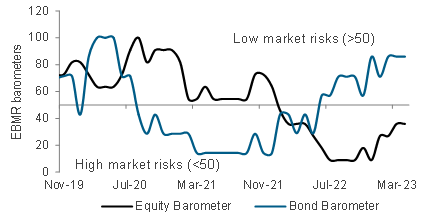
The equity barometer, composed of 11 equity indicators, has been stagnant at 36 after a slight improvement in the prior month. The previous improvement was driven by easing inflation, as US CPI ex Food and Energy y/y fell from 6.6% to 5.5%, and stronger equity market momentum. However, other factors that are typically negative for equities are holding the barometer back. These include falling US housing starts, still high interest rates, weaker commodity prices and reduction in monetary base.
Our bond barometer remains at a strong 86. It is mainly supported by factors that are indicating slower economic growth. They include the ISM Manufacturing PMI, which continues to deteriorate and points towards a contraction in industrial activity, falling US housing starts and lower US capacity utilisation. Lower commodity prices are also a supportive signal for bonds as they do not contribute to inflationary pressure that could lead to higher interest rates. Equity market momentum is currently the only unsupportive factor for the bond barometer, as its recovery typically favours riskier assets over bonds.
Our model projects that the US will remain in Stage 1 until Jul-23. The model is currently consistent with our GIC views where it sees lower downside risks in bonds than equities.
Implications on global assets
Data since 1999 suggest gold and bonds are the most preferred asset classes in Stage 1. The model’s preference for the assets is based on its long-term relationship with the market cycle, which favours gold and bonds as defensive assets in Stage 1.
Fig. 20 Current market scenarios over the coming months vs our December 2022 projections
Probability of the evolution of financial market risk cycle from the current Stage 1 and preferred assets
Model’s estimated probabilities in December 2022
| Stage | Jan-23 | Feb-23 | Mar-23 | Apr-23 |
|---|---|---|---|---|
| 1 | 100% | 99% | 90% | 41% |
| 2 | 0% | 1% | 10% | 58% |
| 3 | 0% | 0% | 0% | 1% |
| 4 | 0% | 0% | 0% | 1% |
Model’s estimated probabilities in May 2023
| Stage | May-23 | Jun-23 | Jul-23 | Aug-23 |
|---|---|---|---|---|
| 1 | 94% | 76% | 47% | 27% |
| 2 | 4% | 22% | 45% | 60% |
| 3 | 2% | 2% | 7% | 10% |
| 4 | 1% | 0% | 1% | 2% |
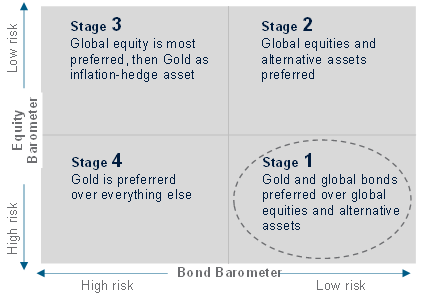
Tracking market diversity
|
About our market diversity indicators
Our market diversity indicators help to identify a potential change in short-term trends due to a fall in market breadth across equities, credit, FX and commodities. When market diversity falls, it implies either buyers or sellers are dominating, leading to a rapid rise or fall in asset prices. This is usually unsustainable and is likely to be followed by a slowdown or a reversal. Our diversity indicator is based on a statistical index called fractal dimension; a value below 1.25 serves as a guideline that prices are rising or falling too fast.
Where is diversity falling or rising this month?
Market diversity across equity, bond and currency markets remains elevated due to the lack of strong trends. In Fig. 21, the average values of our diversity indicators within each asset class can be seen sitting comfortably above 1.25, which is the level when reversal risks rise significantly. There are also no assets within each asset class that have diversity values below the 1.25 cut-off (see Fig. 22).
For bonds, market diversity has tapered off since April but it remains high on average. EM LCY bonds have the lowest diversity at 1.39. This is accompanied by their stronger performance (+4.8% YTD) vs other bond markets. This, however, does not imply a higher reversal risk as its diversity indicator is still a fair bit above 1.25. Meanwhile, EM USD bonds and Asia credits have the highest diversity. Both markets, especially EM USD bonds, lack a clear direction.
Fig. 21 Average market diversity score by asset class
Diversity across asset classes remains elevated
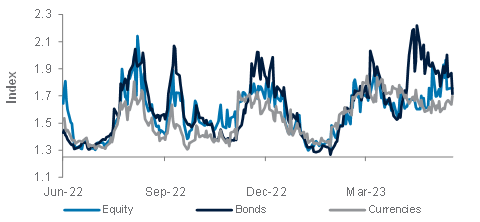
Fig. 22 Percentage of assets with diversity score <1.25
No assets showing reversal risks
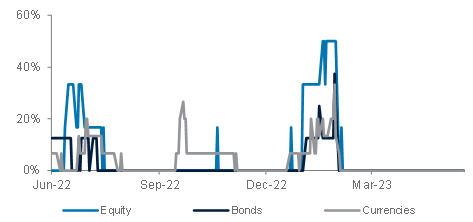
For equities, market diversity across individual markets has generally increased except for the US, UK and Japan. Japan has the lowest diversity, owing to its stellar performance (+14% YTD in local currency terms). Our diversity indicator for Japan equities is at 1.49, indicating low reversal risk. Europe and the UK currently have the highest market diversity. Their corrections in March due to the banking crisis have helped to balance out any supply-demand imbalances.
Meanwhile, the USD index (DXY) has recently rebounded by 3.2% from its April low, after falling by 11.5% from its peak in Sep-22. Our diversity indicator failed to flag the risk of a rebound. However, we cautioned last month that any reversal in the USD weakness is likely to come from expectations of interest rates. This was indeed the driver of the recent USD recovery. Currency pairs with the lowest diversity are GBP/USD, USD/MYR and USD/INR, but none of these reflect significant reversal risk from a market diversity point of view.
Fig. 23 Diversity across key assets
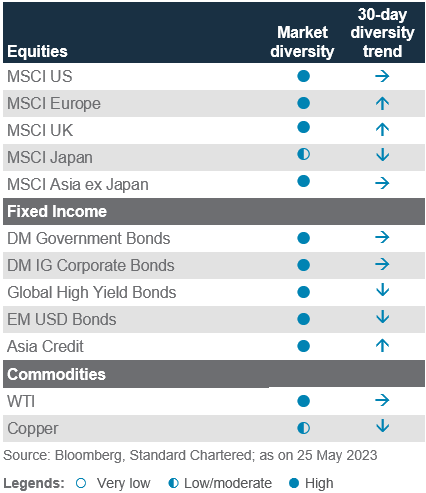
Performance Review
Foundation: Asset allocation summary
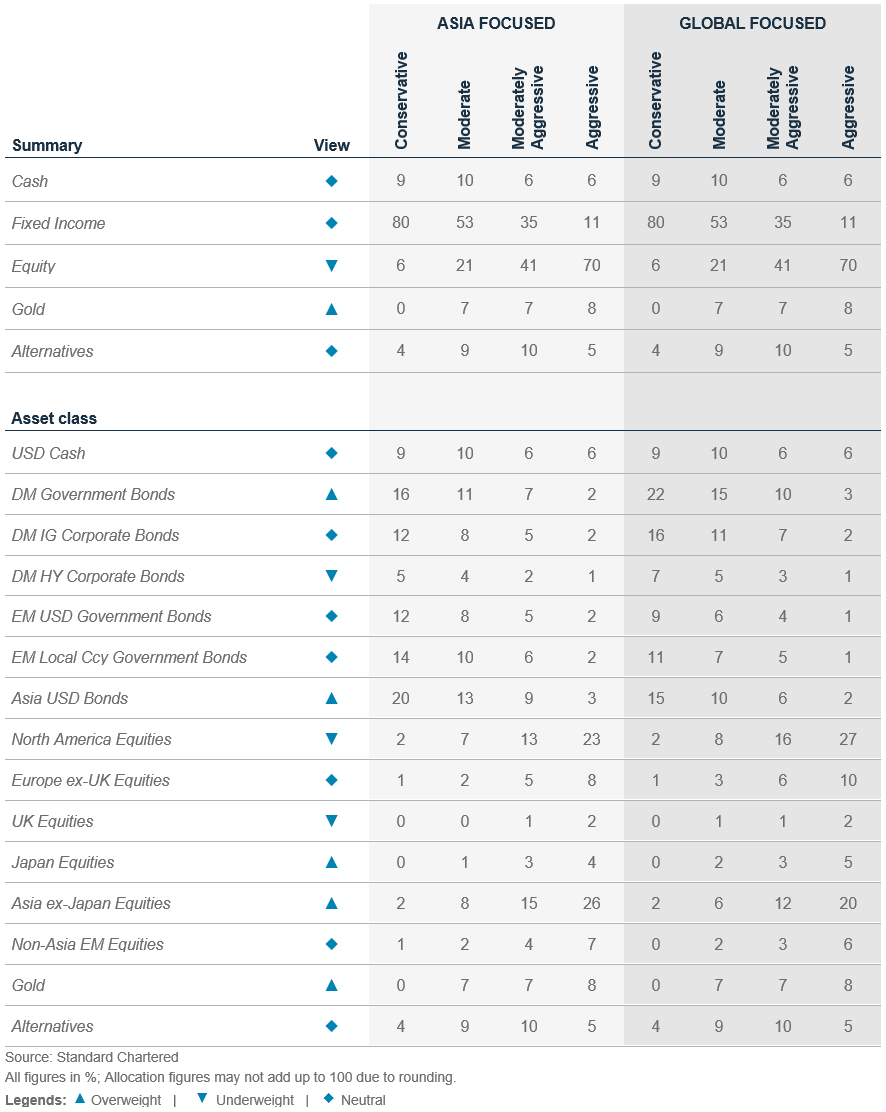
Market performance summary*

*All performance shown in USD terms, unless otherwise stated
*YTD performance data from 31 December 2022 to 25 May 2023 and 1 week-performance from 18 May 2023 to 25 May 2023
Our key forecasts and calendar events
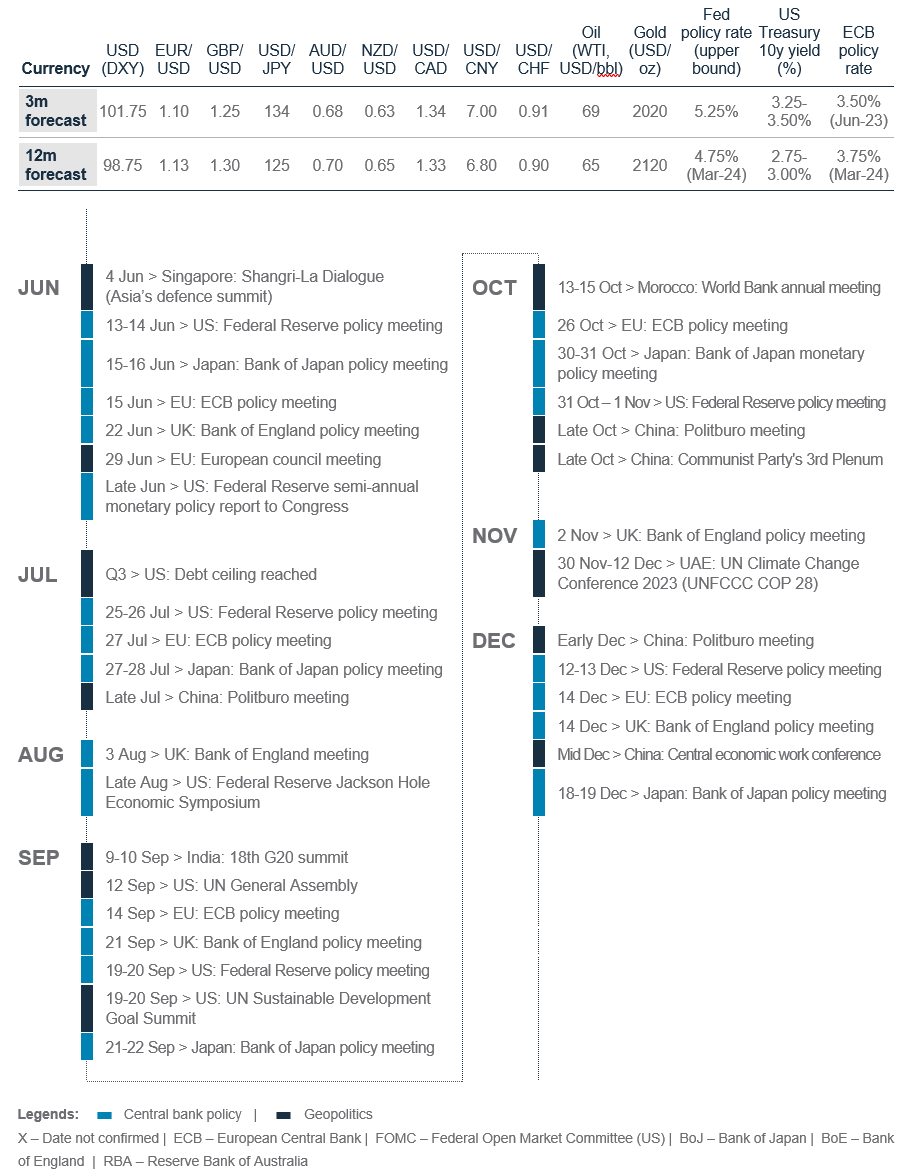
Explanatory notes
1. The figures on page 5 show allocations for a moderate risk profile only – different risk profiles may produce significantly different asset allocation results. Page 5 is only an example, provided for general information only and they do not constitute investment advice, an offer, recommendation or solicitation. They do not take into account the specific investment objectives, needs or risk tolerances of a particular person or class of persons and they have not been prepared for any particular person or class of persons.
2. Contingent Convertibles are complex financial instruments and are not a suitable or appropriate investment for all investors. This document is not an offer to sell or an invitation to buy any securities or any beneficial interests therein. Contingent convertible securities are not intended to be sold and should not be sold to retail clients in the European Economic Area (EEA) (each as defined in the Policy Statement on the Restrictions on the Retail Distribution of Regulatory Capital Instruments (Feedback to CP14/23 and Final Rules) (“Policy Statement”), read together with the Product Intervention (Contingent Convertible Instruments and Mutual Society Shares) Instrument 2015 (“Instrument”, and together with the Policy Statement, the “Permanent Marketing Restrictions”), which were published by the United Kingdom’s Financial Conduct Authority in June 2015), other than in circumstances that do not give rise to a contravention of the Permanent Marketing Restrictions.
Disclosure
This document is confidential and may also be privileged. If you are not the intended recipient, please destroy all copies and notify the sender immediately. This document is being distributed for general information only and is subject to the relevant disclaimers available at our Standard Chartered website under Regulatory disclosures. It is not and does not constitute research material, independent research, an offer, recommendation or solicitation to enter into any transaction or adopt any hedging, trading or investment strategy, in relation to any securities or other financial instruments. This document is for general evaluation only. It does not take into account the specific investment objectives, financial situation or particular needs of any particular person or class of persons and it has not been prepared for any particular person or class of persons. You should not rely on any contents of this document in making any investment decisions. Before making any investment, you should carefully read the relevant offering documents and seek independent legal, tax and regulatory advice. In particular, we recommend you to seek advice regarding the suitability of the investment product, taking into account your specific investment objectives, financial situation or particular needs, before you make a commitment to purchase the investment product. Opinions, projections and estimates are solely those of SC at the date of this document and subject to change without notice. Past performance is not indicative of future results and no representation or warranty is made regarding future performance. The value of investments, and the income from them, can go down as well as up, and you may not recover the amount of your original investment. You are not certain to make a profit and may lose money. Any forecast contained herein as to likely future movements in rates or prices or likely future events or occurrences constitutes an opinion only and is not indicative of actual future movements in rates or prices or actual future events or occurrences (as the case may be). This document must not be forwarded or otherwise made available to any other person without the express written consent of the Standard Chartered Group (as defined below). Standard Chartered Bank is incorporated in England with limited liability by Royal Charter 1853 Reference Number ZC18. The Principal Office of the Company is situated in England at 1 Basinghall Avenue, London, EC2V 5DD. Standard Chartered Bank is authorised by the Prudential Regulation Authority and regulated by the Financial Conduct Authority and Prudential Regulation Authority. Standard Chartered PLC, the ultimate parent company of Standard Chartered Bank, together with its subsidiaries and affiliates (including each branch or representative office), form the Standard Chartered Group. Standard Chartered Private Bank is the private banking division of Standard Chartered. Private banking activities may be carried out internationally by different legal entities and affiliates within the Standard Chartered Group (each an “SC Group Entity”) according to local regulatory requirements. Not all products and services are provided by all branches, subsidiaries and affiliates within the Standard Chartered Group. Some of the SC Group Entities only act as representatives of Standard Chartered Private Bank and may not be able to offer products and services or offer advice to clients.
Copyright © 2024, Accounting Research & Analytics, LLC d/b/a CFRA (and its affiliates, as applicable). Reproduction of content provided by CFRA in any form is prohibited except with the prior written permission of CFRA. CFRA content is not investment advice and a reference to or observation concerning a security or investment provided in the CFRA SERVICES is not a recommendation to buy, sell or hold such investment or security or make any other investment decisions. The CFRA content contains opinions of CFRA based upon publicly-available information that CFRA believes to be reliable and the opinions are subject to change without notice. This analysis has not been submitted to, nor received approval from, the United States Securities and Exchange Commission or any other regulatory body. While CFRA exercised due care in compiling this analysis, CFRA, ITS THIRD-PARTY SUPPLIERS, AND ALL RELATED ENTITIES SPECIFICALLY DISCLAIM ALL WARRANTIES, EXPRESS OR IMPLIED, INCLUDING, BUT NOT LIMITED TO, ANY WARRANTIES OF MERCHANTABILITY OR FITNESS FOR A PARTICULAR PURPOSE OR USE, to the full extent permitted by law, regarding the accuracy, completeness, or usefulness of this information and assumes no liability with respect to the consequences of relying on this information for investment or other purposes. No content provided by CFRA (including ratings, credit-related analyses and data, valuations, model, software or other application or output therefrom) or any part thereof may be modified, reverse engineered, reproduced or distributed in any form by any means, or stored in a database or retrieval system, without the prior written permission of CFRA, and such content shall not be used for any unlawful or unauthorized purposes. CFRA and any third-party providers, as well as their directors, officers, shareholders, employees or agents do not guarantee the accuracy, completeness, timeliness or availability of such content. In no event shall CFRA, its affiliates, or their third-party suppliers be liable for any direct, indirect, special, or consequential damages, costs, expenses, legal fees, or losses (including lost income or lost profit and opportunity costs) in connection with a subscriber’s, subscriber’s customer’s, or other’s use of CFRA’s content.
Market Abuse Regulation (MAR) Disclaimer
Banking activities may be carried out internationally by different branches, subsidiaries and affiliates within the Standard Chartered Group according to local regulatory requirements. Opinions may contain outright “buy”, “sell”, “hold” or other opinions. The time horizon of this opinion is dependent on prevailing market conditions and there is no planned frequency for updates to the opinion. This opinion is not independent of Standard Chartered Group’s trading strategies or positions. Standard Chartered Group and/or its affiliates or its respective officers, directors, employee benefit programmes or employees, including persons involved in the preparation or issuance of this document may at any time, to the extent permitted by applicable law and/or regulation, be long or short any securities or financial instruments referred to in this document or have material interest in any such securities or related investments. Therefore, it is possible, and you should assume, that Standard Chartered Group has a material interest in one or more of the financial instruments mentioned herein. Please refer to our Standard Chartered website under Regulatory disclosures for more detailed disclosures, including past opinions/ recommendations in the last 12 months and conflict of interests, as well as disclaimers. A covering strategist may have a financial interest in the debt or equity securities of this company/issuer. This document must not be forwarded or otherwise made available to any other person without the express written consent of Standard Chartered Group.
Sustainable Investments
Any ESG data used or referred to has been provided by Morningstar, Sustainalytics, MSCI or Bloomberg. Refer to 1) Morningstar website under Sustainable Investing, 2) Sustainalytics website under ESG Risk Ratings, 3) MCSI website under ESG Business Involvement Screening Research for more information. The ESG data is as at the date of publication based on data provided, is for informational purpose only and is not warranted to be complete, timely, accurate or suitable for a particular purpose, and it may be subject to change. Sustainable Investments (SI): This refers to funds that have been classified as ‘Sustainable Investments’ by Morningstar. SI funds have explicitly stated in their prospectus and regulatory filings that they either incorporate ESG factors into the investment process or have a thematic focus on the environment, gender diversity, low carbon, renewable energy, water or community development. For equity, it refers to shares/stocks issued by companies with Sustainalytics ESG Risk Rating of Low/Negligible. For bonds, it refers to debt instruments issued by issuers with Sustainalytics ESG Risk Rating of Low/Negligible, and/or those being certified green, social, sustainable bonds. For structured products, it refers to products that are issued by any issuer who has a Sustainable Finance framework that aligns with Standard Chartered’s Green and Sustainable Product Framework, with underlying assets that are part of the Sustainable Investment universe or separately approved by Standard Chartered’s Sustainable Finance Governance Committee.
Country/Market Specific Disclosures
Botswana: This document is being distributed in Botswana by, and is attributable to, Standard Chartered Bank Botswana Limited which is a financial institution licensed under the Section 6 of the Banking Act CAP 46.04 and is listed in the Botswana Stock Exchange. Brunei Darussalam: This document is being distributed in Brunei Darussalam by, and is attributable to, Standard Chartered Bank (Brunei Branch) | Registration Number RFC/61 and Standard Chartered Securities (B) Sdn Bhd | Registration Number RC20001003. Standard Chartered Bank is incorporated in England with limited liability by Royal Charter 1853 Reference Number ZC18. Standard Chartered Securities (B) Sdn Bhd is a limited liability company registered with the Registry of Companies with Registration Number RC20001003 and licensed by Brunei Darussalam Central Bank as a Capital Markets Service License Holder with License Number BDCB/R/CMU/S3-CL and it is authorised to conduct Islamic investment business through an Islamic window. China Mainland: This document is being distributed in China by, and is attributable to, Standard Chartered Bank (China) Limited which is mainly regulated by National Financial Regulatory Administration (NFRA), State Administration of Foreign Exchange (SAFE), and People’s Bank of China (PBOC). Hong Kong: In Hong Kong, this document, except for any portion advising on or facilitating any decision on futures contracts trading, is distributed by Standard Chartered Bank (Hong Kong) Limited (“SCBHK”), a subsidiary of Standard Chartered PLC. SCBHK has its registered address at 32/F, Standard Chartered Bank Building, 4-4A Des Voeux Road Central, Hong Kong and is regulated by the Hong Kong Monetary Authority and registered with the Securities and Futures Commission (“SFC”) to carry on Type 1 (dealing in securities), Type 4 (advising on securities), Type 6 (advising on corporate finance) and Type 9 (asset management) regulated activity under the Securities and Futures Ordinance (Cap. 571) (“SFO”) (CE No. AJI614). The contents of this document have not been reviewed by any regulatory authority in Hong Kong and you are advised to exercise caution in relation to any offer set out herein. If you are in doubt about any of the contents of this document, you should obtain independent professional advice. Any product named herein may not be offered or sold in Hong Kong by means of any document at any time other than to “professional investors” as defined in the SFO and any rules made under that ordinance. In addition, this document may not be issued or possessed for the purposes of issue, whether in Hong Kong or elsewhere, and any interests may not be disposed of, to any person unless such person is outside Hong Kong or is a “professional investor” as defined in the SFO and any rules made under that ordinance, or as otherwise may be permitted by that ordinance. In Hong Kong, Standard Chartered Private Bank is the private banking division of SCBHK, a subsidiary of Standard Chartered PLC. Ghana: Standard Chartered Bank Ghana Limited accepts no liability and will not be liable for any loss or damage arising directly or indirectly (including special, incidental or consequential loss or damage) from your use of these documents. Past performance is not indicative of future results and no representation or warranty is made regarding future performance. You should seek advice from a financial adviser on the suitability of an investment for you, taking into account these factors before making a commitment to invest in an investment. To unsubscribe from receiving further updates, please send an email to feedback.ghana@sc.com. Please do not reply to this email. Call our Priority Banking on 0302610750 for any questions or service queries. You are advised not to send any confidential and/or important information to Standard Chartered via e-mail, as Standard Chartered makes no representations or warranties as to the security or accuracy of any information transmitted via e-mail. Standard Chartered shall not be responsible for any loss or damage suffered by you arising from your decision to use e-mail to communicate with the Bank. India: This document is being distributed in India by Standard Chartered in its capacity as a distributor of mutual funds and referrer of any other third party financial products. Standard Chartered does not offer any ‘Investment Advice’ as defined in the Securities and Exchange Board of India (Investment Advisers) Regulations, 2013 or otherwise. Services/products related securities business offered by Standard Charted are not intended for any person, who is a resident of any jurisdiction, the laws of which imposes prohibition on soliciting the securities business in that jurisdiction without going through the registration requirements and/or prohibit the use of any information contained in this document. Indonesia: This document is being distributed in Indonesia by Standard Chartered Bank, Indonesia branch, which is a financial institution licensed, registered and supervised by Otoritas Jasa Keuangan (Financial Service Authority). Jersey: In Jersey, Standard Chartered Private Bank is the Registered Business Name of the Jersey Branch of Standard Chartered Bank. The Jersey Branch of Standard Chartered Bank is regulated by the Jersey Financial Services Commission. Copies of the latest audited accounts of Standard Chartered Bank are available from its principal place of business in Jersey: PO Box 80, 15 Castle Street, St Helier, Jersey JE4 8PT. Standard Chartered Bank is incorporated in England with limited liability by Royal Charter in 1853 Reference Number ZC 18. The Principal Office of the Company is situated in England at 1 Basinghall Avenue, London, EC2V 5DD. Standard Chartered Bank is authorised by the Prudential Regulation Authority and regulated by the Financial Conduct Authority and Prudential Regulation Authority. The Jersey Branch of Standard Chartered Bank is also an authorised financial services provider under license number 44946 issued by the Financial Sector Conduct Authority of the Republic of South Africa. Jersey is not part of the United Kingdom and all business transacted with Standard Chartered Bank, Jersey Branch and other SC Group Entity outside of the United Kingdom, are not subject to some or any of the investor protection and compensation schemes available under United Kingdom law. Kenya: This document is being distributed in Kenya by, and is attributable to Standard Chartered Bank Kenya Limited. Investment Products and Services are distributed by Standard Chartered Investment Services Limited, a wholly owned subsidiary of Standard Chartered Bank Kenya Limited that is licensed by the Capital Markets Authority as a Fund Manager. Standard Chartered Bank Kenya Limited is regulated by the Central Bank of Kenya. Malaysia: This document is being distributed in Malaysia by Standard Chartered Bank Malaysia Berhad. Recipients in Malaysia should contact Standard Chartered Bank Malaysia Berhad in relation to any matters arising from, or in connection with, this document. Nigeria: This document is being distributed in Nigeria by Standard Chartered Bank Nigeria Limited, a bank duly licensed and regulated by the Central Bank of Nigeria. Standard Chartered accepts no liability for any loss or damage arising directly or indirectly (including special, incidental or consequential loss or damage) from your use of these documents. You should seek advice from a financial adviser on the suitability of an investment for you, taking into account these factors before making a commitment to invest in an investment. To unsubscribe from receiving further updates, please send an email to clientcare.ng@sc.com requesting to be removed from our mailing list. Please do not reply to this email. Call our Priority Banking on 01-2772514 for any questions or service queries. Standard Chartered shall not be responsible for any loss or damage arising from your decision to send confidential and/or important information to Standard Chartered via e-mail, as Standard Chartered makes no representations or warranties as to the security or accuracy of any information transmitted via e-mail. Pakistan: This document is being distributed in Pakistan by, and attributable to Standard Chartered Bank (Pakistan) Limited having its registered office at PO Box 5556, I.I Chundrigar Road Karachi, which is a banking company registered with State Bank of Pakistan under Banking Companies Ordinance 1962 and is also having licensed issued by Securities & Exchange Commission of Pakistan for Security Advisors. Standard Chartered Bank (Pakistan) Limited acts as a distributor of mutual funds and referrer of other third-party financial products. Singapore: This document is being distributed in Singapore by, and is attributable to, Standard Chartered Bank (Singapore) Limited (Registration No. 201224747C/ GST Group Registration No. MR-8500053-0, “SCBSL”). Recipients in Singapore should contact SCBSL in relation to any matters arising from, or in connection with, this document. SCBSL is an indirect wholly owned subsidiary of Standard Chartered Bank and is licensed to conduct banking business in Singapore under the Singapore Banking Act, 1970. Standard Chartered Private Bank is the private banking division of SCBSL. IN RELATION TO ANY SECURITY OR SECURITIES-BASED DERIVATIVES CONTRACT REFERRED TO IN THIS DOCUMENT, THIS DOCUMENT, TOGETHER WITH THE ISSUER DOCUMENTATION, SHALL BE DEEMED AN INFORMATION MEMORANDUM (AS DEFINED IN SECTION 275 OF THE SECURITIES AND FUTURES ACT, 2001 (“SFA”)). THIS DOCUMENT IS INTENDED FOR DISTRIBUTION TO ACCREDITED INVESTORS, AS DEFINED IN SECTION 4A(1)(a) OF THE SFA, OR ON THE BASIS THAT THE SECURITY OR SECURITIES-BASED DERIVATIVES CONTRACT MAY ONLY BE ACQUIRED AT A CONSIDERATION OF NOT LESS THAN S$200,000 (OR ITS EQUIVALENT IN A FOREIGN CURRENCY) FOR EACH TRANSACTION. Further, in relation to any security or securities-based derivatives contract, neither this document nor the Issuer Documentation has been registered as a prospectus with the Monetary Authority of Singapore under the SFA. Accordingly, this document and any other document or material in connection with the offer or sale, or invitation for subscription or purchase, of the product may not be circulated or distributed, nor may the product be offered or sold, or be made the subject of an invitation for subscription or purchase, whether directly or indirectly, to persons other than a relevant person pursuant to section 275(1) of the SFA, or any person pursuant to section 275(1A) of the SFA, and in accordance with the conditions specified in section 275 of the SFA, or pursuant to, and in accordance with the conditions of, any other applicable provision of the SFA. In relation to any collective investment schemes referred to in this document, this document is for general information purposes only and is not an offering document or prospectus (as defined in the SFA). This document is not, nor is it intended to be (i) an offer or solicitation of an offer to buy or sell any capital markets product; or (ii) an advertisement of an offer or intended offer of any capital markets product. Deposit Insurance Scheme: Singapore dollar deposits of non-bank depositors are insured by the Singapore Deposit Insurance Corporation, for up to S$100,000 in aggregate per depositor per Scheme member by law. Foreign currency deposits, dual currency investments, structured deposits and other investment products are not insured. This advertisement has not been reviewed by the Monetary Authority of Singapore. Taiwan: SC Group Entity or Standard Chartered Bank (Taiwan) Limited (“SCB (Taiwan)”) may be involved in the financial instruments contained herein or other related financial instruments. The author of this document may have discussed the information contained herein with other employees or agents of SC or SCB (Taiwan). The author and the above-mentioned employees of SC or SCB (Taiwan) may have taken related actions in respect of the information involved (including communication with customers of SC or SCB (Taiwan) as to the information contained herein). The opinions contained in this document may change, or differ from the opinions of employees of SC or SCB (Taiwan). SC and SCB (Taiwan) will not provide any notice of any changes to or differences between the above-mentioned opinions. This document may cover companies with which SC or SCB (Taiwan) seeks to do business at times and issuers of financial instruments. Therefore, investors should understand that the information contained herein may serve as specific purposes as a result of conflict of interests of SC or SCB (Taiwan). SC, SCB (Taiwan), the employees (including those who have discussions with the author) or customers of SC or SCB (Taiwan) may have an interest in the products, related financial instruments or related derivative financial products contained herein; invest in those products at various prices and on different market conditions; have different or conflicting interests in those products. The potential impacts include market makers’ related activities, such as dealing, investment, acting as agents, or performing financial or consulting services in relation to any of the products referred to in this document. UAE: DIFC – Standard Chartered Bank is incorporated in England with limited liability by Royal Charter 1853 Reference Number ZC18.The Principal Office of the Company is situated in England at 1 Basinghall Avenue, London, EC2V 5DD. Standard Chartered Bank is authorised by the Prudential Regulation Authority and regulated by the Financial Conduct Authority and Prudential Regulation Authority. Standard Chartered Bank, Dubai International Financial Centre having its offices at Dubai International Financial Centre, Building 1, Gate Precinct, P.O. Box 999, Dubai, UAE is a branch of Standard Chartered Bank and is regulated by the Dubai Financial Services Authority (“DFSA”). This document is intended for use only by Professional Clients and is not directed at Retail Clients as defined by the DFSA Rulebook. In the DIFC we are authorised to provide financial services only to clients who qualify as Professional Clients and Market Counterparties and not to Retail Clients. As a Professional Client you will not be given the higher retail client protection and compensation rights and if you use your right to be classified as a Retail Client we will be unable to provide financial services and products to you as we do not hold the required license to undertake such activities. For Islamic transactions, we are acting under the supervision of our Shariah Supervisory Committee. Relevant information on our Shariah Supervisory Committee is currently available on the Standard Chartered Bank website in the Islamic banking section For residents of the UAE – Standard Chartered Bank UAE does not provide financial analysis or consultation services in or into the UAE within the meaning of UAE Securities and Commodities Authority Decision No. 48/r of 2008 concerning financial consultation and financial analysis. Uganda: Our Investment products and services are distributed by Standard Chartered Bank Uganda Limited, which is licensed by the Capital Markets Authority as an investment adviser. United Kingdom: In the UK, Standard Chartered Bank is authorised by the Prudential Regulation Authority and regulated by the Financial Conduct Authority and Prudential Regulation Authority. This communication has been approved by Standard Chartered Bank for the purposes of Section 21 (2) (b) of the United Kingdom’s Financial Services and Markets Act 2000 (“FSMA”) as amended in 2010 and 2012 only. Standard Chartered Bank (trading as Standard Chartered Private Bank) is an authorised financial services provider (license number 45747) in terms of the South African Financial Advisory and Intermediary Services Act, 2002. The Materials have not been prepared in accordance with UK legal requirements designed to promote the independence of investment research, and that it is not subject to any prohibition on dealing ahead of the dissemination of investment research. Vietnam: This document is being distributed in Vietnam by, and is attributable to, Standard Chartered Bank (Vietnam) Limited which is mainly regulated by State Bank of Vietnam (SBV). Recipients in Vietnam should contact Standard Chartered Bank (Vietnam) Limited for any queries regarding any content of this document. Zambia: This document is distributed by Standard Chartered Bank Zambia Plc, a company incorporated in Zambia and registered as a commercial bank and licensed by the Bank of Zambia under the Banking and Financial Services Act Chapter 387 of the Laws of Zambia.
